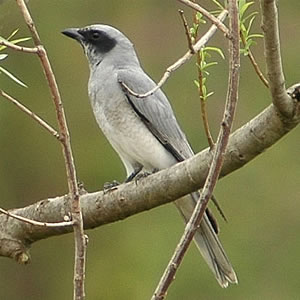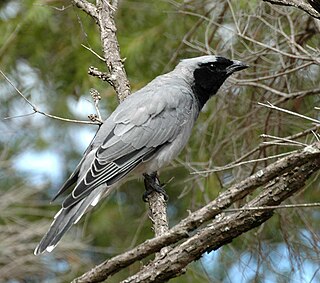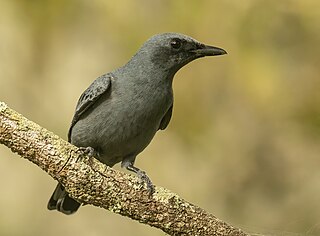
The cuckooshrikes and allies in the family Campephagidae are small to medium-sized passerine bird species found in the subtropical and tropical Africa, Asia and Australasia. The 93 species are divided into 11 genera. The woodshrikes (Tephrodornis) were often considered to be in this family but are now placed in their own family, Vangidae, along with the philentomas and the flycatcher-shrikes. Another genus, Chlamydochaera, which has one species, the black-breasted fruithunter, was often placed in this family but has now been shown to be a thrush (Turdidae).

The pygmy cuckooshrike is a species of bird in the cuckooshrike family Campephagidae. It is endemic to the Indonesian island of Sulawesi. Its natural habitat is subtropical or tropical moist montane forests.

Coracina is a large genus of birds in the cuckooshrike family Campephagidae.

The New Caledonian cuckooshrike or New Caledonian cicadabird is a species of bird in the family Campephagidae. It is endemic to New Caledonia. Some taxonomists place this species in the genus Analisoma.

The blue cuckooshrike is a species of bird in the Cuckooshrike family, Campephagidae. It is widespread across the African tropical rainforest, from Sierra Leone and Liberia to eastern and south-western Democratic Republic of Congo. Its natural habitats are subtropical or tropical dry forests and subtropical or tropical moist lowland forests.
The Solomons cicadabird, also known as Solomons cuckooshrike and black-bellied cicadabird, is a species of bird in the family Campephagidae. It is found in the north and central islands of the Solomon Islands archipelago. Its natural habitat is subtropical or tropical moist lowland forests. It is threatened by habitat loss. It was formerly considered to be conspecific with the Malaita cicadabird.

McGregor's cuckooshrike or the sharp-tailed cuckooshrike, is a species of bird in the family Campephagidae. It is endemic to Mindanao island on the Philippines. Its natural habitat is tropical moist montane forest. It is declining due to habitat loss.

The black cicadabird, also known as the New Guinea cuckooshrike or New Guinea cicadabird, is a species of bird in the family Campephagidae. It is found in the Aru Islands and New Guinea. Its natural habitats are subtropical or tropical moist lowland forest and subtropical or tropical mangrove forest.

The black-bellied cuckooshrike or black-bellied cicadabird is a species of bird in the family Campephagidae. It is found in New Guinea. Its natural habitats are subtropical or tropical moist lowland forest and subtropical or tropical moist montane forest.

The Sulawesi cicadabird is a species of bird in the family Campephagidae. It is endemic to Sulawesi in Indonesia. Its natural habitats are subtropical or tropical moist lowland forests and subtropical or tropical moist montane forests. The species is placed in the reinstated genus Edolisoma by some authors and the nominate subspecies E. morio morio was suggested to be part of the Edolisoma tenuirostre complex in a molecular phylogenetic study by Pedersen et al. (2018).

The grey-headed cuckooshrike, also known as the grey-headed cicadabird or black-tipped cicadabird, is a species of bird in the family Campephagidae. It is found in New Guinea. Its natural habitats are subtropical or tropical moist lowland forest and subtropical or tropical mangrove forest.
The Sula cicadabird, also known as the Sula cuckooshrike or Moluccan graybird, is a species of bird in the family Campephagidae. It is endemic to Indonesia.

The common cicadabird, also known as the slender-billed cicadabird, is a species of bird in the family Campephagidae. It is found in Australia, Indonesia, New Guinea, and the Solomon Islands. Its natural habitats are temperate forest and subtropical or tropical moist lowland forest. The species is placed in the reinstated genus Edolisoma by most authors. The common cicadabird was described as a "great speciator" by Mayr & Diamond (2001); and Pedersen et al. (2018) described how this species rapidly colonized and diversified across the Indo-Pacific island region and Australia in the Pleistocene.

The Manus cuckooshrike is a species of bird in the family Campephagidae. It is found in the Admiralty Islands. Its natural habitats are subtropical or tropical moist lowland forest, subtropical or tropical mangrove forest, and subtropical or tropical moist montane forest. It was formerly considered a subspecies of the white-bellied cuckooshrike.
The grey-capped cicadabird or Melanesian cicadabird is a species of bird in the family Campephagidae. It is endemic to the Bismarck Archipelago. It was previously considered conspecific with the common cicadabird.

Lobotos is a genus of bird in the cuckooshrike family Campephagidae. It is sometimes included in the genus Campephaga. It contains the following two species:

Lalage is a genus of passerine birds belonging to the cuckooshrike family Campephagidae, many of which are commonly known as trillers. There are about 18 species which occur in southern Asia and Australasia with a number of species on Pacific islands. They feed mainly on insects and fruit. They build a neat cup-shaped nest high in a tree.
The Admiralty cicadabird or Manus cicadabird is a species of bird in the family Campephagidae. It is endemic to the Admiralty Islands. It was previously considered conspecific with the common cicadabird.

Ceblepyris is a genus of African passerine birds in the cuckooshrike family Campephagidae.
The Malaita cicadabird is a passerine bird in the family Campephagidae that is endemic to the island of Malaita in the Solomon Islands archipelago. It was formerly considered to be a subspecies of the Solomons cicadabird.























